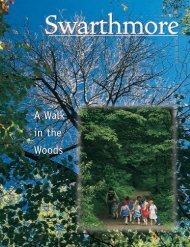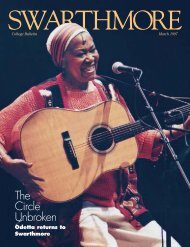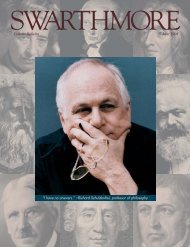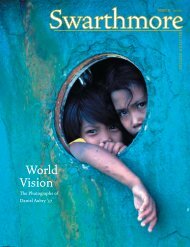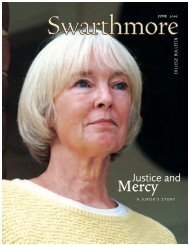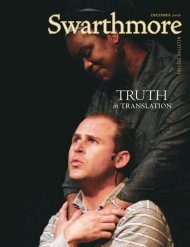A L U M N I P R O F I L ES W A R T H M O R E C O L L E G E B U L L E T I NO nB r o a d w a yT H E A T E R T R A D I T I O N S I N S P I R E T H E A R T O F J E S S I C A W I N E R ’ 8 4 .PHOTOS BY PHILIP GREENBERGJESSICA WINER’S “CURTAIN CALL” WAS PAINTEDFOR MANHATTAN’S TIMES SQUARE VISITORS CENTER.The Great White Wayhas been enhanced bya 14- by 25-foot mural ofNew York’s Broadway legendsdisplayed insideManhattan’s Times SquareVisitors Center.Titled “Curtain Call,” itwas painted and installedin 1998 by Jessica Winer inonly seven weeks. Theacrylic-on-canvas muralcaptures a century ofimages of renownedBroadway actors, actresses,playwrights, composers,and producers,including Ethel Merman,who is center stage.New York artist Winer’sgreatest inspirations comefrom the theater. Even as agirl, she created showposters for the White BarnTheater in Westport, Conn.At Swarthmore, she paintedbackdrops for playswritten by sister DeborahWiner ’83.Winer received the commission forthe project from Gretchen Dykstra,who then headed the Times SquareBusiness Improvement District. Winerhad been looking for an outdoor wall topaint, and Dykstra was looking for anartist to paint an inside wall in thesoon-to-be-renovated Embassy Theater,now called the Times Square VisitorsCenter. Ideas were meshed, and Winerundertook the job.The mural was to have displayed100 notables, but “a committee wasmaking the decisions as to who shouldappear,” Winer said. “When I got thefinal list, there were 200 names,” Winercontinued, her voice still soundingshocked. With the help of “a ton ofbooks,” Winer began the project.Among the people depicted areHelen Hayes, Ira and George Gershwin,Paul Robeson, Laurence Olivier, BenVereen, Patti Lupone, Danny Kaye,Chita Rivera, and Arthur Miller.“I didn’t just copy an image from abook. I used the pictures I saw—andthere were several for each—and determinedhow I would place them in perspectiveon the canvas,” Winer said.Installing the mural requiredresourcefulness and ingenuity. But, intheater lingo: The show must go on.“I was working with an engineer whowas going to build the stretchers forthe six canvas panels and then installthem on the wall. Unfortunately, hebroke two ribs and was unable to helpout. So my sister and I ended up goingto a lumberyard, building the stretcherstrips, stretching the canvases, andthen screwing the whole thing to thewall in a day and a half,” Winer said.“Two hours before the press were toarrive [on Aug. 31, 1998], the wholeplace was a mess, with carpenters andworkers, and stuff was everywhere. Butwhen the doors opened, everythingwas in place, including my mural. It wasincredible,” said Winer, who was followedby a PBS crew for a documentaryon the project.Although Winer was given a smallstipend for her costs, the money shereceived was a token, so contractuallythe mural belongs to her.“This means, if anythingever happens to the building,like they want it torndown, I will get the muralback,” she said.Ownership of her art issomething she learnedabout the hard way atSwarthmore.In the spring of 1983,Winer was asked by PatriciaBoyer, thendirector of theSwarthmore DanceProgram, topaint a mural onwood for the HallGym (now the siteof the Lang PerformingArts Center).When the gym wastorn down, no onethought to ask ifWiner wanted themural back, and itwas destroyed.Winer’s work isknown throughoutManhattan. Her paintings haveappeared on products for the MetropolitanOpera, in The New Yorker magazine,and in the windows of Saks FifthAvenue. She also had two solo showsat Lincoln Center. Her watercolor paintingof the famed Flatiron Building wasrecently acquired by the Museum ofthe City of New York—a gift from ElizabethSanford Carey ’82 and her husband,Jeffrey.“I enjoy working in a large format.You become one with it. It feels like youcan walk into the painting. I want thatfor the spectator, too—to be a part ofit,” she said.She remembers hearing Kaori Kitao,the William R. Kenan, Jr., Professor ofArt History, give a talk on “Why Be anArt History Major?”“Her answer was, ‘you won’t makemoney. It won’t get you a job, but you’llalways be happy.’“Art is what I do best. I understandit better than anything else. I totally getit, and I love doing it.”—Audree Penner58
I N M Y L I F ES W A R T H M O R E C O L L E G E B U L L E T I NL e a r n i n g t o P a c k L i g h t l yBy Kirsten Schwind ’96Today, I’m returning to Guatemalaafter six months at home in California.I heft my backpack around themetal bar that divides Guatemala fromMexico, shove my passport at anamused immigration official, andsqueeze onto a semiretired Blue Birdschool bus along with about 70 indigenousfarmers and local merchants sitting6 across. I’ve made the 14-hourtrek from San Cristobal de las Casas,Chiapas, to Guatemala City manytimes, and it still feels awkward: mybackpack, full of stuff that seemedimportant when I packed that morning,won’t fit in the overhead luggage rackalong with the modest bundles of theother passengers.Once again, I lose out in the subtlecompetition for shoulder space againstthe seat back and end up leaning forwardfor two hours with an elderlyman’s sleepy head knocking at myshoulder blades over the bumps. Butthe good thing is that I’m next to a window,with a view of some of the mostbreathtaking scenery in Central America:a soaring black canyon and dramaticallytilted plateaus, where improbablecornfields sprout from sheaths ofrock. Then I realize my arm is stuck toa pink blob of recently chewed gumsquashed on the window pane. My lifehere isn’t always as romantic as Iremember it.Two years in Guatemala and Chiapashave injected me into an experienceso incongruous with my comfortableSilicon Valley childhood; Swarthmoreacademia; and former Washington,D.C., government contract job thatI’m still trying to figure out how theseworlds can coexist on the same planet.In my second week of working forWitness for Peace, a social justiceorganization that educates U.S.activists about the effects of our foreignpolicy abroad (and stores itsarchives in the Peace Collection ofMcCabe Library), I visited survivors ofone of Guatemala’s 626 governmentsponsoredmassacres of civilians duringthe 36-year counterinsurgency warthat ended in 1996.I thought the first time hearing massacretestimony must be the hardest,How can peoplewho shoot theirneighbors go hometo their families?But then, knowingmy family’s taxmoney fundedU.S. military aidto Guatemala,how can I?AN ENVIRONMENTAL ACTIVIST ADDRESSES ACOMMUNITY MEETING IN NORTHERN GUATEMALA,WHERE REMAINING RAIN-FOREST LANDS AREHOTLY DISPUTED AMONG OIL, LOGGING, AGRI-CULTURAL, AND CONSERVATION INTERESTS.but it wasn’t. I got to know the survivorsas people I could joke with laterthat evening over a meal of beans andtortillas around their kitchen fire andcame to think of them as no moredeserving of tragedy in their lives thanI. In Acteal, Chiapas, a Tzotzil Maya villagethat was the site of Mexico’s worstrecent massacre in 1997, I was pulledinto a throng of dancers bouncing to abuoyant cumbia pumped out by thesame local band that had played at amass for the 45 victims a few weeksearlier. “Long live human rights!” theysang. These expressions of defiant joyand fun made their losses most humanto me, not just woeful headlines fromsome underdeveloped country, wherethese things just happen and will probablyalways keep happening.For about a year, my main reactionto hearing about human rights violationswas a low-burning, self-righteousoutrage. This was evil on a scale I hadnever met face to face in the UnitedKIRSTEN SCHWIND64





